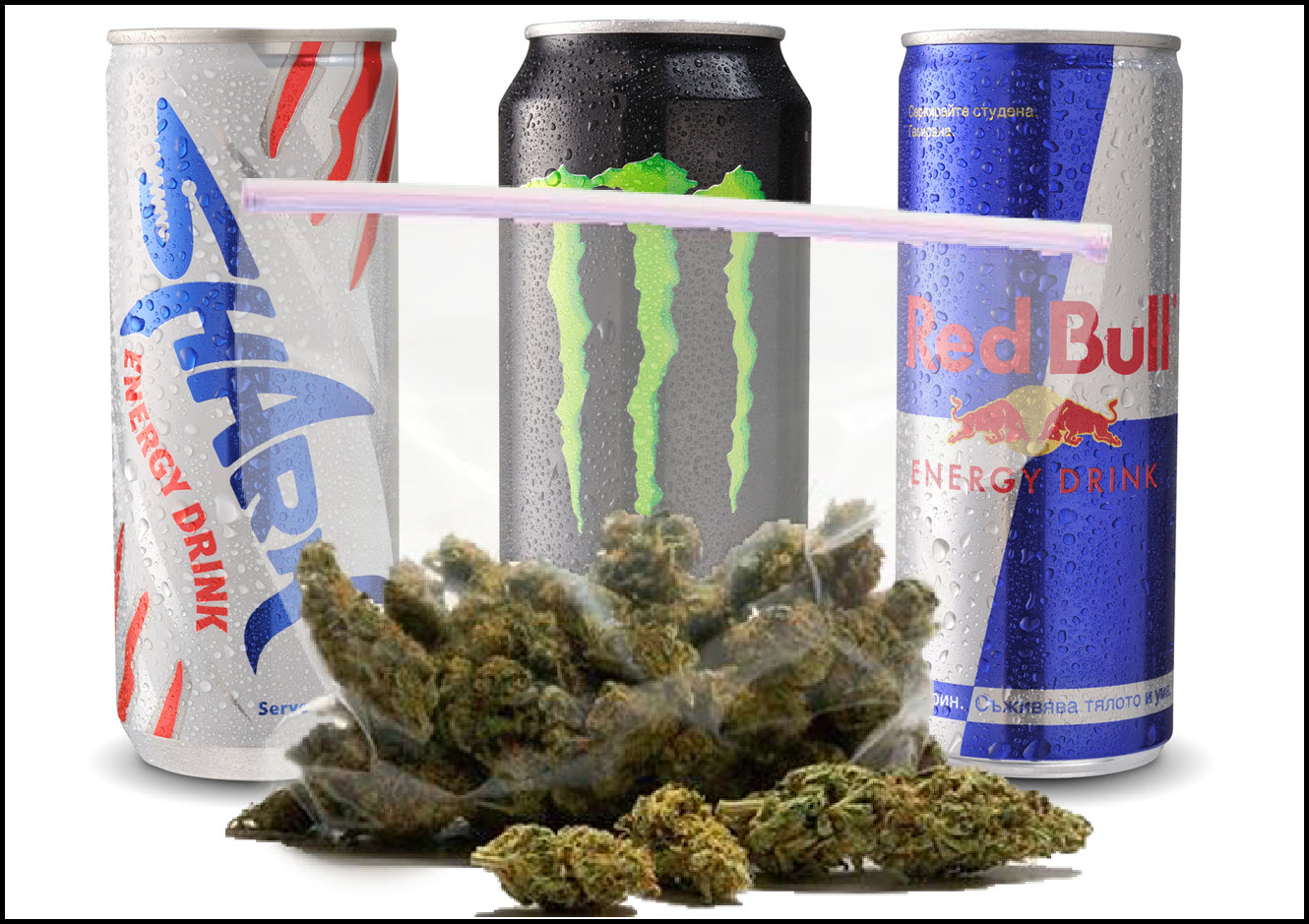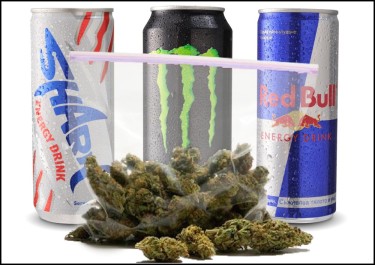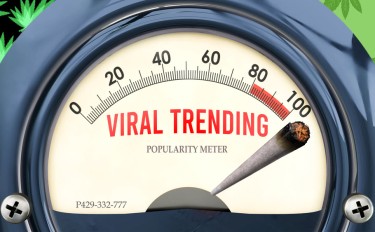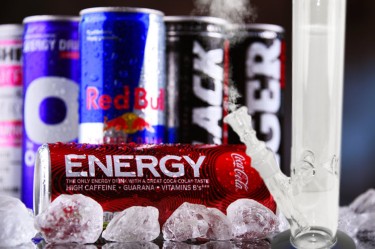Cannabis News
Smoking Weed and Drinking an Energy Drink?
Published
6 months agoon
By
admin

Why You Shouldn’t Mix Cannabis With Energy Drinks – A Dangerous Interaction You Should Avoid
It’s surprising how popular energy drinks still are.
Different forms of energy drinks have been around for centuries, but it wasn’t until the 1960’s when Japan developed the first range of modern energy drinks. Fast-forward to several decades later, and various energy drinks are still widely developed and consumed all over the United States. These drinks have been valued by customers for its supposed claims of increasing mental and physical energy, or giving one a much-needed energy boost that caffeine alone apparently can’t do.
Energy drinks are made with a mix of ingredients; of course, they differ according to brand and formulation but they usually contain a combination of the followings stimulating ingredients: caffeine, vitamins, sugar, herbal extracts, guarana, ginseng, and taurine. These drinks target young adults, typically between 18 to 28 years of age though they are also widely consumed by older adults aged 26-39. This demographic is associated with college or grad school students, busy office workers, entrepreneurs… likely the type of individuals who can benefit from extra energy and endurance for lives that are demanding both mentally and physically.
That said, energy drinks aren’t always safe. There has been a notable rise in emergency room visits due to energy drink usage.
After all, it’s no secret that energy drinks are notorious for their potential danger. The excessive amount of stimulants and sugar in one drink can be dangerous, especially when combined with sedatives – including cannabis.
Why Is Mixing Red Bull With Weed Dangerous?
Combining sedatives or relaxants, such as weed, with caffeine – isn’t anything new. In fact, so many people make it part of their morning routine: wake and bake.
Wake up, light up a bowl, and enjoy a cup of coffee before you go on to start your day. There’s nothing wrong with that, in fact many enjoy the combination provided that it’s done in moderation. Some people even mix weed into their coffee, such as by dropping cannabis oil with a cup of joe.
This is even referred to as a speedball, or specifically, the Seattle speedball. Many entrepreneurs, artists, and creative types benefit from this type of combination because weed and coffee get them to the state they need to be productive.
However, the caffeine in coffee is so much lower compared to the stimulants contained in energy drinks.
Can cannbais replace your 5-hour energy shot or Monster energy drink?
Just imagine how dangerous energy drinks could be when a few sips alone can already send you to the emergency room and possibly cause a heart attack. Imagine mixing it with a downer like alcohol, or a relaxing substance like weed. Well, depending on what strain you smoke – some weed strains are a stimulant, especially if you are consuming sativa or sativa-dominant strains. In some cases, weed can also cause palpitations on its own. It really depends on your tolerance as well as many other factors.
Cardiovascular issues and possible heart attacks
Red Bull, for example, contains around 80 mg of caffeine. Meanwhile, one serving of coffee yields around 40 to 100 mg of caffeine depending on the size. Red Bull contains an unusually high amount of caffeine but that’s not all: it also contains other stimulants that can quite literally get your heart racing.
Meanwhile, cannabis induces a psychoactive state which can cause either inhibition or stimulation depending on the strain and amount smoked, combining both substances together can result in severely high heart rate, paranoia, anxiety, headaches, dizziness, high blood pressure, and confusion.
In addition, both substances may also heighten the side effects of both caffeine and the THC in marijuana. According to studies, this is because the cannabinoid system and the adenosine system in the human body can interact as a result of consuming caffeine and weed. We can’t emphasize the risk of heart problems enough when you consume energy drinks; these beverages are notorious at quickly increasing one’s blood pressure to unhealthy levels, and sometimes, this can be fatal.
Other possible side effects
Mixing weed and energy drinks can also result in other unwanted side effects. For one, it can affect your sleep. Caffeine in high doses, especially in the form of energy drinks, can make it much harder to fall and stay asleep especially when consumed later in the day.
Furthermore, these stimulants can upset your stomach. It can cause nausea, acid reflux, or diarrhea particularly when consumed together for long periods of time.
For individuals with existing health problems
Anyone who already has pre-existing health problems and complications, such as high blood pressure, history of cardiovascular disease, or just about anything – just stay away from energy drinks completely. Mixing it with weed shouldn’t even be considered at all. Both substances can exert severe pressure on the human body and result in unwanted side effects.
Conclusion
Always listen to your doctor or a health care professional. If your desire to explore the world of energy drinks is out of desperation for more mental or physical energy, remember that there are many other healthier alternatives. For example, you can consider integrating matcha, green tea, fresh coconut water, and yerba mate into your diet. Exercising more, getting proper sleep, and eating well can all have a tremendous impact on your energy. The right marijuana strains can help, too.
The bottom line is that mixing energy drinks with weed can be a fatal and risky mistake. Toss the energy drinks and stick to weed, with healthier alternatives. Last but not least: consult your doctor.
CANNABIS AND ENERGY DRINK IDEAS, READ ON…
You may like
-


Linked In Post – Jon Dennis, Psychedelic Lawyer: Washington SB 5201, the regulated psilocybin access bill, was considered today by the Senate Committee on Labor & Commerce ( 18 Feb 2025)
-


The rapid collapse of MedMen co-founders’ latest marijuana venture
-


David Downs’ sickest weed genetics picks of 2025
-


The Future King of Cannabis will be THC-Infused Beverages
-


What You Need to Know about the Viral Medical Study Claiming Cannabis Causes Memory Loss
-


Russia detains another American for cannabis (Newsletter: February 17, 2025)
Cannabis News
The Future King of Cannabis will be THC-Infused Beverages
Published
23 hours agoon
February 18, 2025By
admin

As someone who’s been dancing with Mary Jane for over two decades, I’ve watched the cannabis industry evolve from simple flower into an endless array of innovative products. I’ve tried just about every form of cannabis imaginable – from traditional joints to high-tech dabs, from basic brownies to sophisticated gummies, and everything in between.
For most old-school stoners like myself, smoking flower still reigns supreme. Sure, concentrates have carved out their niche, and edibles have certainly found their place in the cannabis kingdom. But there’s one product category that remains tantalizingly out of reach, one holy grail that could revolutionize not just cannabis consumption, but potentially reshape the entire recreational substance industry.
I’m talking about cannabis beverages. Now, before you rush to tell me they already exist – trust me, I know. But what’s currently on the market isn’t even close to what it needs to be. The first company to crack this code – to create the perfect cannabis drink that rivals the ease and social experience of cracking open a beer – stands to make billions.
This isn’t just speculation. Recent market research suggests we’re on the cusp of a beverage revolution, and cannabis is perfectly positioned to lead the charge. Let’s explore why the future king of cannabis isn’t a product that you smoke, dab, or eat – it’s one you’ll drink.
The numbers don’t lie, and they’re telling us something extraordinary. According to a recent study published in the British Food Journal, roughly 53-56% of beer drinkers are open to trying cannabis-infused beverages. Let that sink in for a moment. We’re not talking about a small niche market here – we’re talking about potentially converting half of the beer-drinking population into cannabis beverage consumers.
To put this in perspective, the U.S. beer market generates approximately $100 billion annually. If even a quarter of those open to trying cannabis beverages became regular consumers, we’re looking at a potential market worth tens of billions of dollars. This isn’t just a business opportunity; it’s an industry-defining moment waiting to happen.
But here’s the catch – and it’s a big one. When someone cracks open a beer, they generally know what to expect. Whether it’s a light beer at 4% alcohol or a craft brew at 7%, drinkers understand their limits. Through years of social drinking, people have learned their “sweet spot” – maybe it’s two beers for a pleasant buzz, or three for a livelier evening. The standardization of alcohol content has created a predictable, manageable drinking experience.
Cannabis beverages, however, are still stuck in the Wild West phase. Sure, you might see “10mg THC” printed on the can, but that same dose can floor one person while barely affecting another. The inconsistency isn’t just about individual tolerance – it’s about the fundamental challenge of creating a standardized cannabis drinking experience. Absorption rates vary wildly, onset times are unpredictable, and the overall effects can be all over the map.
This inconsistency is the Achilles’ heel of the current cannabis beverage market. Until someone figures out how to create a product that delivers a consistent, predictable experience – something as reliable as cracking open a Bud Light or a Corona – cannabis beverages will remain a novelty rather than the industry titan they could become.
Major players have already dipped their toes into the cannabis beverage pool. Companies like Pabst Blue Ribbon have launched cannabis-infused seltzers, while Lagunitas offers their Hi-Fi Hops drinks. Even beverage giant Constellation Brands (the folks behind Corona) invested billions in Canopy Growth, signaling big alcohol’s serious interest in the space. Yet, despite these heavy hitters throwing their hats in the ring, we still haven’t seen the breakthrough product that could truly revolutionize the market.
The fundamental challenge lies in creating a standardized drinking experience. Currently, most cannabis beverages rely on traditional THC infusion methods, which leads to unpredictable absorption rates and that dreaded “wait and see” game that’s familiar to anyone who’s eaten an edible. Some companies are experimenting with nano-emulsification technology to make THC molecules more water-soluble, potentially leading to faster onset times and more consistent effects. But we’re not quite there yet.
Here’s where things get really tricky: when cannabis is processed through the liver (as it is with traditional edibles and current beverages), it gets converted into 11-Hydroxy-THC, which packs roughly four times the punch of regular THC. This is why you might feel fine after one cannabis beverage, then suddenly find yourself on Mars after the second one kicks in. Unlike alcohol, where you can generally gauge your level of intoxication as you drink, cannabis beverages can stack up in unexpected ways, leading to the dreaded “green out.”
What the industry needs is some sort of revolutionary chemistry – perhaps a form of THC that bypasses liver processing, or a formulation that caps the conversion to 11-Hydroxy-THC. Maybe it’s about developing a cannabis beverage that provides a short-lived buzz, similar to alcohol’s relatively predictable duration. Or perhaps it’s about creating a self-limiting effect that prevents overconsumption.
The solutions might seem elusive, but the potential reward is staggering. The first company to crack this code – to create a cannabis beverage that allows people to drink socially without fear of unexpected intensity or duration – will essentially be sitting on a gold mine. We’re talking about potentially billions in revenue, not to mention the distinction of creating an entirely new category of social consumption.
The challenge is complex, but the market is ready. With over half of beer drinkers expressing interest in cannabis beverages, the demand is clearly there. Now it’s just a matter of who will solve the chemistry puzzle first. As someone who’s watched this industry evolve for decades, I can tell you – that breakthrough is coming. And when it does, it will fundamentally change not just how we consume cannabis, but potentially how we socialize altogether.
THC-INFUSED BEVERAGES ARE HERE, READ ON…
SORRY, NO BOOZE SERVED – MIAMI FESTIVAL ONLY SERVES THC DRINKS!
Cannabis News
What You Need to Know about the Viral Medical Study Claiming Cannabis Causes Memory Loss
Published
2 days agoon
February 17, 2025By
admin

What You Should Really Know About The Viral Study Claiming Cannabis Causes Memory Loss
Over the past week, we’ve been seeing the same viral news appear on almost every internet news or media outlet.
It’s news surrounding the results of a controversial study, claiming that cannabis use can cause memory loss, especially when consumption patterns are on the heavy side. Researchers from the University of Colorado Anschutz Medical Campus conducted what is considered to be the biggest study of its kind, specifically analyzing the impact of both lifetime and recent cannabis use on the cognitive function of over 1,000 individuals whose ages ranged from 22 to 36.
For the purposes of the study, heavy users were defined as the young adults who consumed weed over a thousand times in their lifetime. On the other hand, moderate users were defined as those who used 10 to 999 times, whole nonusers were those who consumed nonusers. They used MRI tests to assess neural activity among participants, and they were all given a variety of cognitive tasks to complete; the tasks tested different functions in the brain including memory, motor skills, language, emotion, and reward.
Additionally, the investigators used brain imaging technology to measure working memory, which refers to the brain’s short-term storage of information. Humans use working memory in everyday problem solving, reasoning, and other activities.
They found that there was a statistically significant impact on the working memory tasks given to participants, which meant that it was not likely due to coincidence. The dramatic impact was observed among the lifetime and recent cannabis consumers, though it was less significant when compared to other tasks.
“We applied the highest standards to our research, setting rigorous thresholds for statistical significance across all seven cognitive function tests. To minimize the risk of false positives, we employed false discovery rate (FDR) correction. While some of the other tasks indicated potential cognitive impairment, only the working memory task showed a statistically significant impact,” explains Joshua Gowin, PhD, the paper’s first author and an assistant professor of radiology at the University of Colorado School of Medicine and the University of Colorado Anschutz Medical Campus. Specifically, the researchers discovered that the parts of the brain that are responsible for decision making, emotional processing, attention, and memory showed reduced activity among heavy cannabis users.
The Role of Abstaining
While this might come as a shock, it’s important to note that Gowin explains their findings suggest users can abstain from smoking cannabis before engaging in cognitive tasks, since this can help performance.
“People need to be aware of their relationship with cannabis since abstaining cold turkey could disrupt their cognition as well. For example, heavy users may need to be more cautious,” Gowin explains.
The effects of abstaining can depend on several factors, such as an individual’s history of cannabis use, the task at hand, and various biochemical individual differences. Adding to what Gowin said, there are certainly several potential benefits that users can expect when abstaining from weed, especially when they expect to do a mentally-burdensome task. These include an improvement in cognitive function, better concentration and focus, and sharper clarity as well as alertness.
But Can Cannabis Actually Improve Cognitive Function?
Studies have proven time and again that cannabis affects everyone differently. So while weed use can make some people sharper and more focused with cognitive tasks, it may not have the same effect for others – or even the majority of a population, as seen in this study.
There are also other studies proving that cannabis actually improves cognitive function in others, or doesn’t affect it at all. For example, Dr Staci Gruber’s Marijuana Investigations for Neuroscientific Discovery (MIND) program of the McLean Hospital discovered through longitudinal observational studies that medical marijuana patients showed improved performances in cognitive tasks that required them to use executive functioning.
“Rather than getting worse, they’re actually getting better,” explained Gruber. Gruber and her team are focused on analyzing the impact of cannabis and its impact on cognition, function, quality of life, and brain structure. According to her, this can be attributed to patients who can think more clearly since since their symptoms have been alleviated due to medical marijuana use. However, earlier cannabis use, or regular consumption before the age of 16, is still never recommended because this has been found to severely affect cognitive development and performance later on.
Another study, whose findings were presented at the 2018 annual Society for Neuroscience Meeting, found that animal subjects with Alzheimer’s disease, who were treated with THC, showed significant improvemnets in memory and even lost less brain cells compared to those that weren’t. This could be revolutionary if a breakthrough memory or Alzheimer’s medicine could be developed, which included THC.
Conclusion
In short, the viral study claiming that marijuana can affect your memory should be taken with a grain of salt. It’s just one of many studies backing up the fact that weed will always affect people differently, given that there are already several other studies backing up the use of cannabis to improve cognition – even among medical marijuana users who suffer from physical ailments.
Cannabis certainly does offer neuroprotective benefits for the brain, and it can aid with other cognitive functions including creativity, sleep, reduction in anxiety, and much more. We must still remember that even with studies proving this, cannabis use during adolescence should be prohibited and keep in mind that individual variability will always play a role in the outcome.
MARIJUANA USE AND MEMORY FUNCTION, READ ON…
WHY ARE BABY BOOMERS RUSHING TO CANNABIS TO IMPROVE THEIR MEMORY?
Cannabis News
Chairman of High Times Pleads Guilty to $20 Million in Securities Fraud, Then Decides to Change His Guilty Plea?
Published
5 days agoon
February 14, 2025By
admin

In a significant development within the cannabis industry, Adam Levin, the chairman of Hightimes Holding Corp., has agreed to plead guilty to conspiracy charges related to a scheme involving undisclosed payments made to an investment analyst. Or is he? Adam plans to change his guilty plea in a new court proceeding that is coming up. So what gives?
Th original scheme aimed to promote Hightimes’ securities offering, raising serious questions about transparency and ethical practices in the burgeoning cannabis market. As the industry continues to navigate regulatory challenges and public scrutiny, this case highlights the complexities and potential pitfalls that companies face as they seek to capitalize on the growing acceptance of cannabis.
Background on Hightimes Holding Corp.
Hightimes Holding Corp., the parent company of the iconic cannabis culture brand High Times, has been a prominent player in the cannabis industry since its inception. Founded in 1974, High Times has long been associated with cannabis advocacy, culture, and education. Over the years, it has evolved into a multimedia company encompassing print publications, events, and digital platforms focused on cannabis.
In recent years, as legalization efforts gained momentum across various states in the U.S., Hightimes sought to capitalize on this trend by transitioning into a publicly traded entity. In 2020, the company announced its intention to go public through a reverse merger with a publicly traded shell company. This move was seen as a way for Hightimes to access capital markets and fund its expansion initiatives.
However, the journey has not been without its challenges. The company has faced various legal and financial hurdles, including allegations of fraud and operational mismanagement that ultimately led to its receivership in 2024. These issues have raised concerns among investors regarding the company’s governance and financial practices.
The Scheme Uncovered
The recent developments surrounding Adam Levin center on allegations that he participated in a scheme to make undisclosed payments to an investment analyst who promoted Hightimes’ securities offering. According to court documents filed on December 20, 2024, Levin agreed to plead guilty to conspiracy charges related to this arrangement.
The scheme reportedly involved over $150,000 in payments made to the analyst as part of an effort to artificially inflate investor interest in Hightimes’ stock. By compensating the analyst for favorable coverage without disclosing these payments, Levin and others involved sought to create a misleading impression of demand for the company’s securities. This lack of transparency is particularly concerning given the regulatory environment surrounding securities offerings, which mandates full disclosure of any compensation arrangements that could influence an analyst’s recommendations.
The Investigation into this scheme was initiated by both the U.S. Department of Justice (DOJ) and the Securities and Exchange Commission (SEC), highlighting a broader scrutiny of practices within the cannabis industry. As more companies enter this rapidly evolving market, regulators are increasingly vigilant about ensuring compliance with securities laws and protecting investors from potential fraud.
## Legal Consequences
As part of his plea agreement, Adam Levin is set to appear in court on January 17, 2025. He faces a potential maximum sentence of five years in federal prison for his role in the conspiracy. The plea agreement indicates that Levin is cooperating with authorities as they continue their investigation into Hightimes and its business practices.
The legal ramifications extend beyond Levin himself; they also raise questions about corporate governance within Hightimes Holding Corp. The company’s board of directors will likely face increased scrutiny regarding their oversight responsibilities and whether they adequately monitored Levin’s actions.
In addition to potential criminal charges for individuals involved in such schemes, companies can also face civil penalties from regulatory agencies like the SEC. These penalties can include fines, disgorgement of profits obtained through fraudulent activities, and restrictions on future business operations.
Implications for Hightimes Holding Corp.
The fallout from Levin’s plea agreement is likely to have significant implications for Hightimes Holding Corp. The company has already been grappling with various challenges related to its financial stability and reputation within the industry. The revelation of this scheme adds another layer of complexity to an already precarious situation.
1. Investor Confidence
One immediate concern is how this development will affect investor confidence in Hightimes Holding Corp. Investors are increasingly cautious about putting their money into companies embroiled in legal controversies or allegations of fraud. Given that Hightimes has already faced scrutiny over its business practices, this latest revelation could deter potential investors from participating in future funding rounds or purchasing shares.
2. Regulatory Scrutiny
The ongoing investigation by federal authorities is likely to result in heightened regulatory scrutiny for Hightimes Holding Corp. Companies operating within the cannabis space must navigate a complex web of federal and state regulations; any indication of wrongdoing can lead regulators to take a closer look at a company’s operations. This increased scrutiny may result in further investigations or audits that could disrupt business operations and hinder growth prospects.
3. Reputation Damage
Hightimes has built its brand around cannabis culture and advocacy; however, allegations of unethical practices can tarnish its reputation among consumers and advocates alike. As public perception plays a crucial role in the success of cannabis companies, any damage done to Hightimes’ reputation could have long-lasting effects on its market position and ability to attract customers.
4. Operational Challenges
With Levin’s impending court appearance and potential sentencing looming over the company, operational challenges may arise as key leadership figures are embroiled in legal battles. Uncertainty regarding leadership stability can create internal disruptions that hinder decision-making processes essential for navigating an evolving market landscape.
Cannabis Industry Challenges
Levin’s case is not an isolated incident but rather part of broader challenges facing the cannabis industry as it matures. As more states legalize cannabis for medical or recreational use—leading some companies toward lucrative opportunities—regulatory compliance becomes increasingly critical.
1. Regulatory Landscape
The regulatory landscape surrounding cannabis remains complex due largely to its classification as a Schedule I substance under federal law despite legalization efforts at state levels. Companies must navigate differing regulations across jurisdictions while ensuring compliance with federal securities laws when seeking investments or going public.
2. Market Competition
As competition intensifies within the cannabis sector—both from established players like Hightimes and new entrants—companies face pressure not only regarding compliance but also profitability metrics that appeal directly toward investors seeking returns on their investments.
3. Public Perception
Public perception plays an essential role in shaping consumer behavior within emerging markets like cannabis; negative headlines can quickly sway opinions against brands perceived as engaging in unethical practices or lacking transparency—further complicating efforts toward building trust among consumers who prioritize ethical sourcing methods when choosing products they consume.
Conclusion
The case involving Adam Levin, chairman of Hightimes Holding Corp., underscores critical issues of transparency and ethical conduct within the cannabis industry, highlighting the potential legal and reputational repercussions that can arise from undisclosed financial arrangements. As Levin prepares to plead guilty to conspiracy charges related to undisclosed payments aimed at promoting the company’s securities offering, this incident serves as a cautionary tale for cannabis companies navigating the complexities of regulatory compliance and investor relations. The fallout from this case not only threatens Hightimes’ financial stability and investor confidence but also reflects broader challenges facing the industry as it matures, emphasizing the need for robust corporate governance and ethical practices to foster trust among consumers and investors alike. Ultimately, the developments surrounding Hightimes and Levin illustrate the delicate balance that cannabis companies must maintain between pursuing growth opportunities and adhering to legal and ethical standards in an increasingly scrutinized market.
HIGH TIMES DRAMA GALORE, READ ON…

Linked In Post – Jon Dennis, Psychedelic Lawyer: Washington SB 5201, the regulated psilocybin access bill, was considered today by the Senate Committee on Labor & Commerce ( 18 Feb 2025)

The rapid collapse of MedMen co-founders’ latest marijuana venture

David Downs’ sickest weed genetics picks of 2025

The Future King of Cannabis will be THC-Infused Beverages

What You Need to Know about the Viral Medical Study Claiming Cannabis Causes Memory Loss
Russia detains another American for cannabis (Newsletter: February 17, 2025)

Punjab Police seize 30-kg heroin dropped by Pakistani drone in Amritsar; largest drug seizure of 2025 so far

Best places to smoke weed in Mexico City: local celebs share favorite spots

Celebs’ biggest cannabis products of 2025

MARY Fest 2025: Brooklyn’s Ultimate Cannabis Lifestyle Experience

Distressed Cannabis Business Takeaways – Canna Law Blog™

United States: Alex Malyshev And Melinda Fellner Discuss The Intersection Of Tax And Cannabis In New Video Series – Part VI: Licensing (Video)

What you Need to Know

Drug Testing for Marijuana – The Joint Blog

NCIA Write About Their Equity Scholarship Program

It has been a wild news week – here’s how CBD and weed can help you relax

Cannabis, alcohol firm SNDL loses CA$372.4 million in 2022

A new April 20 cannabis contest includes a $40,000 purse

Your Go-To Source for Cannabis Logos and Designs

UArizona launches online cannabis compliance online course
Trending
-

 Cannabis News2 years ago
Cannabis News2 years agoDistressed Cannabis Business Takeaways – Canna Law Blog™
-

 One-Hit Wonders2 years ago
One-Hit Wonders2 years agoUnited States: Alex Malyshev And Melinda Fellner Discuss The Intersection Of Tax And Cannabis In New Video Series – Part VI: Licensing (Video)
-

 Cannabis 1012 years ago
Cannabis 1012 years agoWhat you Need to Know
-

 drug testing1 year ago
drug testing1 year agoDrug Testing for Marijuana – The Joint Blog
-

 Education2 years ago
Education2 years agoNCIA Write About Their Equity Scholarship Program
-

 Cannabis2 years ago
Cannabis2 years agoIt has been a wild news week – here’s how CBD and weed can help you relax
-

 Marijuana Business Daily2 years ago
Marijuana Business Daily2 years agoCannabis, alcohol firm SNDL loses CA$372.4 million in 2022
-

 California2 years ago
California2 years agoA new April 20 cannabis contest includes a $40,000 purse







